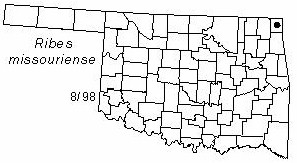Shrub to 2 m (6 ft) tall. Crown irregular, diffuse. Bark almost black. Twigs gray to light tan, glabrous; with 2-3 spines at the nodes, 6-18 mm (0.25-0.75 in) long, but absent in some cases. Leaves alternate, simple, palmate, rounded with 3-5 lobes, 1.8-6.3 cm (0.8-2.5 in) long, glabrous above, softly pubescent beneath, 1.2-3.8 cm (0.5-1.5 in) wide, broadly cuneate to subcordate at base, coarsely toothed. Flowers on peduncles 1-2 cm (0.4-0.8 in) long and drooping, numbering 2-3 flowers per inflorescence, 1-1.2 cm (0.4-0.5 in) long; petals cuneate, obovate, pale green to white; styles 2; stamens 5; flowers appear in March or April. Fruits berries, 8-15 mm (0.3-0.6 in) diameter, subglobose, black-purple, matures June to Septmber.
Distribution: Oklahoma, Arkansas, east to Tennessee, north to Connecticut, west to Minnesota and South Dakota, south to Missouri. Rare in Oklahoma; only one collection from Ottawa County on the Ozark Plateau.
Habitat: mesic slopes and moist soils.
Comment: The genus name, Ribes, is derived from the Danish word "ribs" for the red currant; the species name, missouriense, refers to the state from which the first described specimen was collected.
Wildlife benefit: the berries are eaten by several species of birds.
Horticulture: Fruits may be used for preserves. Missouri gooseberry has been cultivated since 1907.
NWI status: none
Distribution in Oklahoma: 
BACK
NEXT
RETURN TO INDEX
Last update: 9/17/99
 Go to Oklahoma Biological Survey Home Page
Go to Oklahoma Biological Survey Home Page
 Disclaimer
Disclaimer